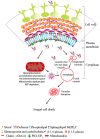Hyperpolarisation of Mitochondrial Membranes Is a Critical Component of the Antifungal Mechanism of the Plant Defensin, Ppdef1
- PMID: 38248963
- PMCID: PMC10817573
- DOI: 10.3390/jof10010054
Hyperpolarisation of Mitochondrial Membranes Is a Critical Component of the Antifungal Mechanism of the Plant Defensin, Ppdef1
Abstract
Plant defensins are a large family of small cationic proteins with diverse functions and mechanisms of action, most of which assert antifungal activity against a broad spectrum of fungi. The partial mechanism of action has been resolved for a small number of members of plant defensins, and studies have revealed that many act by more than one mechanism. The plant defensin Ppdef1 has a unique sequence and long loop 5 with fungicidal activity against a range of human fungal pathogens, but little is known about its mechanism of action. We screened the S. cerevisiae non-essential gene deletion library and identified the involvement of the mitochondria in the mechanism of action of Ppdef1. Further analysis revealed that the hyperpolarisation of the mitochondrial membrane potential (MMP) activates ROS production, vacuolar fusion and cell death and is an important step in the mechanism of action of Ppdef1, and it is likely that a similar mechanism acts in Trichophyton rubrum.
Keywords: Ppdef1; S. cerevisiae; Trichophyton rubrum; antifungal; hyperpolarisation; plant defensin.
Conflict of interest statement
N.L.v.d.W., J.A.M. and M.A.A. are Hexima Ltd. shareholders. N.L.v.d.W. and M.A.A. are inventors of the method for the treatment of fungal infections, EP3209319B1 and US9713632B2. Hexima Ltd. has granted permission to publish the results. We confirm that neither the manuscript nor any parts of its content are currently under consideration or published in another journal. Authors K.P., J.A.M., R.L., K.S.H., R.G., E.L., N.L.v.d.W., M.R.B. and M.A.A. were employed by the company Hexima Ltd. The remaining authors declare that the research was conducted in the absence of any commercial or financial relationships that could be construed as a potential conflict of interest.
Figures










Similar articles
-
The Plant Defensin Ppdef1 Is a Novel Topical Treatment for Onychomycosis.J Fungi (Basel). 2023 Nov 17;9(11):1111. doi: 10.3390/jof9111111. J Fungi (Basel). 2023. PMID: 37998916 Free PMC article.
-
Screening the Saccharomyces cerevisiae Nonessential Gene Deletion Library Reveals Diverse Mechanisms of Action for Antifungal Plant Defensins.Antimicrob Agents Chemother. 2019 Oct 22;63(11):e01097-19. doi: 10.1128/AAC.01097-19. Print 2019 Nov. Antimicrob Agents Chemother. 2019. PMID: 31451498 Free PMC article.
-
Inhibition of cereal rust fungi by both class I and II defensins derived from the flowers of Nicotiana alata.Mol Plant Pathol. 2014 Jan;15(1):67-79. doi: 10.1111/mpp.12066. Epub 2013 Sep 10. Mol Plant Pathol. 2014. PMID: 24015961 Free PMC article.
-
Antifungal defensins and their role in plant defense.Front Microbiol. 2014 Apr 2;5:116. doi: 10.3389/fmicb.2014.00116. eCollection 2014. Front Microbiol. 2014. PMID: 24765086 Free PMC article. Review.
-
Plant defensins.Planta. 2002 Dec;216(2):193-202. doi: 10.1007/s00425-002-0902-6. Epub 2002 Oct 8. Planta. 2002. PMID: 12447532 Review.
Cited by
-
In Vitro and In Vivo Antifungal Efficacy and Safety of the CaDef2.1G27‑K44 Peptide against the Neglected and Drug-Resistant Pathogen.ACS Bio Med Chem Au. 2025 May 13;5(4):620-636. doi: 10.1021/acsbiomedchemau.5c00020. eCollection 2025 Aug 20. ACS Bio Med Chem Au. 2025. PMID: 40860033 Free PMC article.
-
Antifungal activity of indolicidin-derived peptide In-58 against Sporothrix globosa in vitro and in vivo.Front Med (Lausanne). 2024 Sep 12;11:1458951. doi: 10.3389/fmed.2024.1458951. eCollection 2024. Front Med (Lausanne). 2024. PMID: 39328314 Free PMC article.
-
Antifungal Plant Defensins as an Alternative Tool to Combat Candidiasis.Plants (Basel). 2024 May 29;13(11):1499. doi: 10.3390/plants13111499. Plants (Basel). 2024. PMID: 38891308 Free PMC article. Review.
-
The Plant Defensin Ppdef1 Is a Novel Topical Treatment for Onychomycosis.J Fungi (Basel). 2023 Nov 17;9(11):1111. doi: 10.3390/jof9111111. J Fungi (Basel). 2023. PMID: 37998916 Free PMC article.
-
Fighting pathogenic yeasts with plant defensins and anti-fungal proteins from fungi.Appl Microbiol Biotechnol. 2024 Mar 27;108(1):277. doi: 10.1007/s00253-024-13118-1. Appl Microbiol Biotechnol. 2024. PMID: 38536496 Free PMC article. Review.
References
LinkOut - more resources
Full Text Sources
Molecular Biology Databases

